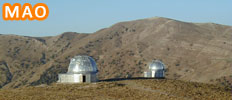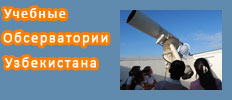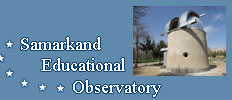| Menu ... |
 |
 |
 |
 |
 |
| Our address |
 |
 |
33 Astronomicheskaya str.,
Tashkent, 100052, Uzbekistan
Phone: +998 71 2358102
Fax: +998 71 2344867
E-mail: info@astrin.uz
|
 |
 |
 |

|

|

|
|
 |
| GRANDMA network |
 |
 |
| «Eyes» of Maidanak observatory looking for GW sources within GRANDMA network |
 |
 |
The Ulugh Beg Astronomical Institute (UBAI) team has been a part of the GRANDMA project since May 2019. UBAI uses two telescopes of its Maidanak astronomical observatory (MAO) for rapid observation of optical counterparts of gravitational wave events, a new way to observe violent phenomena as collision of neutron stars. Maidanak observatory is located at the south-east of the Republic of Uzbekistan in a mountain area with ~2600 m above sea level (66°54 E, 38°40 N). The MAO of the UBAI, due to its location, has a high-quality ‘astroclimate’ — with up to 90% of the nights clear during the summer with median seeing of 0.69 arcsec. Coupled with its unique location, MAO is very attractive for involvement in observing programs requiring uninterrupted monitoring of celestial objects.
The telescopes used are two Zeiss-600 0.6 m Cassegrain ones with an aperture of f/12.5, named according to their relative location at the observatory as Northern (NT-60) and Southern (ST-60) Zeiss-600. They have been operational since the early 80-ths of the past century. The telescopes presently equipped with FLI 1024 × 1024 CCD cameras and BVRI Bessel filters, the FoV is 10.8arcmin × 10.8 arcmin for the NT-60 and 6.5arcmin × 6.5 arcmin for the ST-60. The limiting magnitude in the R filter is 18 mag with a 3 min exposure.
In order to enhance visibility of UBAI and Maidanak observatory participation in the international GRANDMA collaboration, we are going to publish a note in the scientific-popular journal of «Science and life» about the project, its member teams, operation aspects, achievements and publications, which will be placed in the official web-site of UBAI as well.
Maidanak observatory is one of the favorite places of amateur astronomers. In spite of often contacts, UBAI has never discussed the possibility of collaboration in the frame of a professional international project. Recent discussions with their representative, Mr. Maruf Karaev, revealed their readiness for collaboration in this field. A presentation of the Kilonova-catcher program has been planned amongst the local group of amateur astronomers/astrophotographers in order to make them familiar to the citizen science program.
The Ministry of Innovative development of Uzbekistan is an organism which provides help to research institutions. A fund, created 3 years ago in the ministry offered UBAI a budget for a new CCD cameras. Nowadays a CCD camera of Andor company has been ordered for one of the Zeiss-600 telescopes. The camera with a reverse illumination, chip size 2048 x 2048 pixels with pixel size 15x15 micrometers with cooling system downto -60 ° C is expected to be delivered at the end of the year.
The same ministry has announced a call for fundamental projects particularly in astronomy with the deadline of September 2020. Two UBAI laboratories are going to unite their efforts to participate with a project devoted to compact binaries. Teams of theoretical and observational astrophysics will prepare a project which will include observational and theoretical study of compact objects coalescence, reflection model for the X-ray binaries to test the Kerr black hole hypothesis and general relativity.
|
|